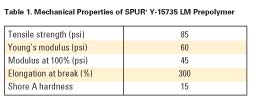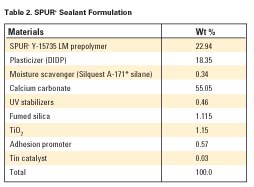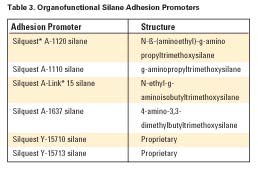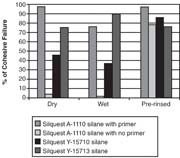
Silane-terminated polyurethanes (SPUR+prepolymers) have become increasingly appealing to adhesives, sealants and coatings manufacturers due to the synergy between the silane-curing mechanism and the polyurethane backbone properties.
Formulations developed using this technology offer fast room-temperature cure and good durability, and the adhesives or sealants they produce are free of unreacted isocyanates, allowing them to have a less harmful impact on the environment. Benefits of the resulting products also include no bubbling during cure, and a broadening of the formulation latitude compared to conventional polyurethane technologies.

- Good elasticity and durability
- Primerless adhesion to both organic and inorganic, porous and non-porous substrates
- Superior resistance to chemicals, such as automotive fluids (glycols, motor and transmission fluids)
- Minimal shrinkage
- Excellent weatherability
- Immediate paintability
- No staining on porous substrates

Reviewing GE's development of SPUR+ prepolymers, we published our first technical article 10 years ago.2 The article contrasted different silane endcappers to the properties of resultant SPUR+ prepolymers. Among those potential endcappers (mercapto-silane, ureidosilane and aminosilanes), a secondary aminosilane, Silquest* Y-9669 (phenylaminopropyltrimethoxysilane), demonstrated the best balance of durability and curing rate. That was GE's first generation of SPUR+ prepolymer technology.


Therefore, a low-viscosity, SPUR+ prepolymer without added plasticizers has become more important, as formulators seek to improve the performance of their products by selecting different plasticizers, or to optimize their properties by mixing thixotropic agents with the prepolymer before addition of the plasticizer. To meet the industry demand, one of the next-generation silylated polyurethane resins is now available: SPUR+ Y-15735 LM prepolymer, low modulus resin.

The Next Generation of SPUR+ Prepolymers
The SPUR+Y-15735 LM prepolymer, the first product in this line, is obtained from the reaction of a -OH terminated SPUR+prepolymer that has been capped by an isocyanato-silane.5 In comparison to SPUR+polymers obtained using amino-silane capping groups, resins prepared using isocyanate silanes have fewer isocyanate hard segments, thereby reducing the potential for the intermolecular hydrogen bonding that results in lower polymer viscosity.
The SPUR+ Y-15735 LM prepolymer is a clear liquid resin. It has a viscosity of ~50K cP and is free of any added plasticizer. The polymer is easily handled, as it is freely flowable at room temperature. Figure 1 shows that the Y-15735 resin offers faster tack-free performance than similar resins prepared using secondary aminosilane capping groups. When mixed with 1 wt% dibutyltin dilaurate in the absence of added fillers, Y-15735 LM is three times as fast in tack-free time, and offers a 50% enhancement in the rate of deep-section cure under ambient conditions.

Additionally, the new-generation prepolymer provides balanced mechanical properties (see Table 1), thus making it an excellent material for the formulation of products for construction, industrial and consumer applications.


The SPUR+ strategic platform is built on technologies in both SPUR+ prepolymers and silane additives. By combining the SPUR+ Y-15735 LM prepolymer with desired silane adhesion promoters, sealant properties can be tailored for different applications. This is demonstrated through a generic formulation shown in Table 2.

For the construction market, sealant flexibility is a fundamental requirement for the ASTM C 920 standard. For the industrial and consumer sectors, modulus and tensile strength are emphasized. Nonyellowing is often important when formulating a white or clear sealant. As demonstrated, selection of the silane adhesion promoter has a dramatic impact on the sealant's performance characteristics.
Adhesion to wet concrete without primer, whether applied on wet concrete or tested after water immersion, is of concern to formulators. As a result of the high pH condition of the wet surface of concrete, the only reliable method to achieve good adhesion has been the initial application of a primer. To satisfy contractor needs, many formulators are striving to gain adhesion without primer.

Conclusion
The next-generation of SPUR+resin technology is a low-viscosity SPUR+prepolymer without added plasticizers, and is the flagship product in a new generation of SPUR+prepolymers. In addition to the advantages, the new SPUR+Y-15735 LM prepolymer provides additional features: non-yellowing, improved tack free, and deep section cure performance. These performance advantages provide formulators with more latitude to optimize their products for industry needs.
Combined with new silane technology, adhesives and sealants formulated with this new prepolymer can provide adhesion to many difficult substrates, including wet concrete. This new development in silane technology helps enable adhesion to wet concrete without use of a primer.
Acknowledgments
The authors gratefully acknowledge Dr. Brendan O'Keefe for his contribution to this project; as well as Mr. Jeries Nesheiwat, Mr. Rob Gorrell, Mr. Jenning Goldsmith, and Mr. Remy Gauthier for syntheses and the property tests reported in this paper. Throughout the development, we acknowledge the many managers and engineers who supported this project, including Dr. Shayne Landon, Dr. Kevin Bobbit, and Mr. John Banevicius.
For more information on SPUR+ prepolymers, contact GE, Advanced Materials, Silicones, www.gesilicones.com.
References
1 Saunder, J.H. Frisch, K.C. Polyurethanes: Chemistry and Technology, Vol. I, Part I, Interscience, NY (1962), p. 273 (b).2 (a) Feng, T.M.; Waldman, B.A. "Silylated Urethane Polymers Enhance Properties of Construction Sealants," Adhesives Age, April 1995. (b) Landon, S.J., Guillet, A.; Johnston, R.R. "Silylated Urethane Polymers for Sealants," European Adhesives and Sealants; Dec. 1995.
3 Landon, S.J.; Dawkins, M.B.; Waldman, B.A.; Johnston, R.R. "The Adhesion of Hybrid Sealants to Plastic Substrates, Adhesives," Adhesives Age, April 1997.
4 Huang, M.W.; Handel, R. "New Developments in Silylated Polyurethane Technology," Adhesives Age, April 1999.
5 Johnston, R.R.; Lehmann, P. US 5,990,257.
* SPUR+, SPUR, Silquest, A-Link and Silquest A-171 are trademarks of General Electric Co. Copyright 2005, General Electric Co.